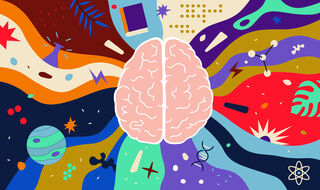Memory
Are Cluttered Minds More Creative?
A lifetime of knowledge can clutter memory banks but may also fuel creativity.
Posted February 13, 2022 Reviewed by Gary Drevitch
Key points
- Creative thinking involves retrieving and associatively combining real-life knowledge (i.e., semantic memories) from one's "memoryscapes."
- Cluttered memoryscapes are common among older adults who've accumulated lots of life experience. Brain clutter has pros and cons.
- A downside of brain clutter is that it's harder to remember details; an upside is that seemingly irrelevant information cultivates creativity.

If Marie Kondo could peek inside your brain and take inventory of your memory banks, would she find it chockablock with clutter? If you're an older adult, odds are that Kondo would find cluttered memoryscapes based on a lifetime of enriched experiences.
Much like there's "life-changing magic" in tidying up our homes, decluttering our minds and organizing semantic memory structures has perks. But how can we "tidy up" cluttered memoryscapes? Does having lots of disorganized clutter in our minds make us more scatterbrained or more creative?
This post attempts to answer these questions based on fresh insights from two papers published in February 2022 that address how the brain organizes semantic memories based on accumulated real-life knowledge. (Note: From a metacognitive perspective, the creative process of comparing this scientific literature is a real-time example of an older adult with a cluttered mind trying to organize my thinking and connect the dots between two seemingly unrelated research papers in a new, and hopefully, useful way.)
Brain Clutter Makes It Harder to Recall Details but May Also Promote Creativity
Accumulating massive amounts of semantic, real-life knowledge across a lifespan has many upsides and a few downsides, especially regarding forgetfulness associated with age-related cognitive decline.
A recent Trends in Cognitive Sciences review (Amer, Wynn, & Hasher, 2022) of numerous studies found that cluttered memory representations can make certain types of cognition related to recalling targeted information more difficult. On the flip side, brain clutter may also enhance creative potential.
After analyzing a variety of neuroimaging and behavioral studies, the trio of researchers from Columbia University, Harvard University, and the University of Toronto found that older adults with cluttered memory representations might have difficulty suppressing information that's no longer relevant while trying to remember a specific episodic memory.
Age-related declines in attentional control often make it harder to stay laser-focused on retrieving a specific episodic memory, especially when Irrelevant information gets jumbled up with the targeted information someone's trying to recall. Brain clutter can make it difficult for older adults to remember precisely when and where something happened in these circumstances.
If someone has a zillion semantic memories, retrieval of targeted information from a specific time and place can be like looking for a needle in a haystack. But the upside of having a sea of knowledge filled with seemingly irrelevant information that bubbles up into someone's consciousness along with targeted details is that random, hodgepodge associations can cultivate creative thinking.
As Tarek Amer, Jordana Wynn, and Lynn Hasher explain, "Cluttered representations can impair memory by interfering with the retrieval of target information, but can also provide an advantage on tasks that benefit from extensive knowledge." Memory-dependent cognitive functions related to the creative process may benefit from cluttered memory representations.

Do Less Segregated Neural Networks Keep Cluttered Brains Tidy?
Returning to the Marie Kondo metaphor of "tidying up" our cluttered brains, another recent study by neuroscientists in France found that whole-brain functional connectivity and less-segregated neural networks were associated with semantic memory structures that predicted real-life creativity. This fMRI-based research suggests that fluid whole-brain connectivity supports creative thinking. These findings (Ovando-Tellez et al., 2022) were published in the peer-reviewed journal Science Advances.
Taken together, both of these papers affirm Sarnoff Mednick's 1962 hypothesis that there's an associative basis to the creative process. Sixty years ago, he described creative thinking as "the forming of associative elements into new combinations which either meet specific requirements or are in some way useful."
Through the lens of Amer, Wynn, and Hasher's research into how cluttered memory representations shape cognition, it seems that older adults' creativity benefits from random associations made when retrieving seemingly irrelevant information—if they can connect the dots in new and useful ways.
Additionally, the latest (2022) findings from Marcela Ovando-Tellez et al. suggest that people who are highly creative benefit from having less modular (i.e., less segregated) neural networks because they're able to access seemingly irrelevant information from distant corners of their minds and reorganize it in ways that lead to creative solutions.
References
Tarek Amer, Jordana S. Wynn, Lynn Hasher. "Cluttered Memory Representations Shape Cognition in Old Age." Trends in Cognitive Sciences (In press, corrected proof first available online: February 11, 2022) DOI: 10.1016/j.tics.2021.12.002
Marcela Ovando-Tellez, Yoed N. Kenett, Mathias Benedek, Matthieu Bernard, Joan Belo, Benoit Beranger, Theophile Bieth, Emmanuelle Volle. "Brain Connectivity–Based Prediction of Real-Life Creativity Is Mediated by Semantic Memory Structure." Science Advances (First published: February 04, 2022) DOI: 10.1126/sciadv.abl4294
Sarnoff A. Mednick. "The Associative Basis of the Creative Process." Psychological Review (1962) DOI: 10.1037/h0048850




